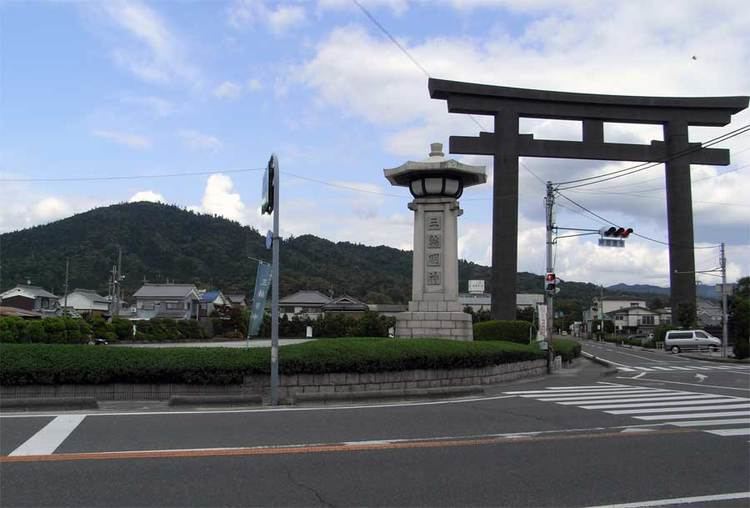Website www.oomiwa.or.jp | Phone +81 744-42-6633 | |
 | ||
Dedicated to ŌmononushiŌnamuchiSukunahikona-no-kamiMount Miwa Similar Mount Miwa, Isonokami Shrine, Miwa Station, Hase‑dera, Kashihara Shrine | ||
Ōmiwa Shrine (大神神社, Ōmiwa-jinja), also known as Miwa Shrine (三輪神社, Miwa-jinja, alternately written as 三輪明神 Miwa-myōjin), is a Shinto shrine located in Sakurai, Nara, Japan. The shrine is noted because it contains no sacred images or objects because it is believed to serve Mount Miwa, the mountain on which it stands. For the same reason, it has a worship hall (拝殿, haiden), but no place for the deity to be housed (神殿, shinden). In this sense, it is a model of what the first Shinto shrines were like. Ōmiwa Shrine is one of the oldest extant Shinto shrines in Japan and the site has been sacred ground for some of the earliest religious practices in Japan. Because of this, it has sometimes been named as Japan's first shrine. Ōmiwa Shrine is a tutelary shrine of the Japanese sake brewers.
Contents
- miwa shrine event data recorder
- History
- Religious significance
- Auxiliary shrines
- Architecture
- Important Cultural Assets
- References
miwa shrine event data recorder
History
Ōmiwa Shrine's history is closely related to Mount Miwa and the religious practices surrounding the mountain. In the early Kofun period, Yamato kings and leaders had shifted their attention to kami worship on Mount Miwa, and Ōmiwa Shrine was the major institution for this branch of worship. The style of Shinto surrounding Miwa became later known as Miwa Shinto, and is set apart from previous practices by a more structured theological philosophy.
The shrine became the object of Imperial patronage during the early Heian period. In 965, Emperor Murakami ordered that Imperial messengers be sent to report important events to the guardian kami of Japan. These heihaku were initially presented to 16 shrines, including Ōmiwa.
Ōmiwa was designated as the chief Shinto shrine (ichinomiya) for the former Yamato Province.
From 1871 through 1946, Ōmiwa was officially designated one of the Kanpei-taisha (官幣大社), meaning that it stood in the first rank among government supported shrines.
Religious significance
The Ōmiwa Shrine is directly linked to Mount Miwa in that the mountain is the shrine's shintai, or "kami-body", instead of a building housing a "kami-body". This type of mountain worship (shintai-zan) is found in the earliest forms of Shinto, and has also been employed at Suwa Shrine in Nagano, and formerly at Isonokami Shrine in Nara and Munakata Shrine in Fukuoka.
According to the chronicle Nihon Shoki, Emperor Sujin appealed to Mount Miwa's kami when Japan was crippled by plague. In response, the kami Ōmononushi demanded rituals be performed for him at Mount Miwa. He then demanded that the rites be led by Ōtata Neko, his half-kami, half-human son born from the union with a woman of the Miwa clan. Ōtata Neko performed the rites to satisfaction, and the plague subsided. A building dedicated to Ōtata Neko was later erected in his honor.
A legendary white snake is said to live in around the shrine, and is supposedly one of the kami worshipped there. Indeed, snakes and the snake cult figures importantly in the myths surrounding Mount Miwa as well as early Shinto in general.
Auxiliary shrines
The Ōmiwa shrine complex includes notable auxiliary shrines (setsumatsusha), including 12 Sessha (摂社, auxiliary shrine) and 28 massha (末社, branch shrine) which are marked by small structures falling under Ōmiwa's jurisdiction. For example, the sessha Ikuhi jinja enshrines the kami who was appointed Ōmiwa's sake brewer in the 4th month of the 8th year of the reign of Emperor Sujin. A poem associated with Ikuhi is said to have been composed by Empress Jingū on the occasion of a banquet for her son, Emperor Ōjin:
Architecture
Ōmiwa Shrine is situated in a quiet forest, and built directly in front of Mount Miwa. An ancient Japanese cedar tree (Cryptomeria) can be found on shrine compound, and is considered sacred. The mountain itself serves as the honden, or main hall, instead of a man-made building.
Decorations in the form of Borromean rings are found throughout the shrine's buildings. This ornamentation symbolizes the three rings, as "Miwa" is written with the kanji for "three" (三) and "ring" (輪).
Built in 1984, at 32 m the torii on its sandō is the second highest in Japan. The shrine also has a great shime torii, an ancient form of gate made only with two posts and a rope called shimenawa. It is one of few shrines that has a "triple-torii" (miwa torii) on its grounds. This gate is also one of the few to actually have doors, which bar access to the mountain it enshrines.
The buildings at Ōmiwa Shrine are a mix of structures built from ancient times to the Edo period.
